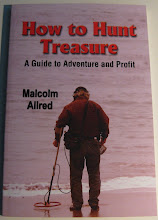 used in courting rituals, thus its phallic shape. Frankly, I would wonder about an Indian who would “blow” such an instrument.
used in courting rituals, thus its phallic shape. Frankly, I would wonder about an Indian who would “blow” such an instrument.The hunt for Indian artifacts is fraught with risks because of antiquities laws. Add to that the moral and psychological implications that come with possibly disturbing the graves of human beings, and you may wonder whether you really want to be a part of the hobby. My experiences in the field have convinced me that I will stick to digging Minie balls and let others pursue Indian artifacts. I have two short tales that illustrate why I came to such conclusion.
First, I had a friend who once located (with his detector) a buried flintlock musket along with bullets (musket balls), coat buttons, etc., in the hills north of Vicksburg near the original fort built by the French in 1721 (the Indians massacred the lot of them in 1729). It appeared that the owner of the relics had perished at this very spot, perhaps a victim of the same tribe who had wiped out the fort. Along with the gun, gun parts, buttons, and other personal effects were many beads of varying sizes, apparently used for trade by the early visitors.
The evening was late when my friend made the discovery, and as he labored in the early darkness he was overcome with a feeling that might best be described as “impending doom.” Gathering his detector, shovel, and the few relics he had unearthed, he hurriedly left the place.
The next day he enlisted my help, insisting that he would not return to the site alone. So I helped him complete the dig. Though he kept a sharp eye out for apparitions or other uncanny visions, the dig was completed without incident. He even shared a portion of his finds with me: a couple of very small beads. I still have those beads, and I think of the jerk each time I come across them.
The second tale begins as I was innocently hunting relics with a metal detector. There is always a possibility that while digging relics you may stumble onto an area where Indian artifacts abound.
 This happened to me years ago when I located a campsite that had been placed squarely atop a burial ground. Each time I dug a Minie ball, I turned up beads and bits of bone and pottery. Curious, I began to dig for Indian artifacts rather than relics of the War. Soon I had uncovered entire skeletons, along with many beads and more broken pottery. Excited at my finds, next day I photographed the excavation, then took for my collection a number of beads, bones, skulls and teeth. At home I set up a small display of the artifacts alongside the photographs.
This happened to me years ago when I located a campsite that had been placed squarely atop a burial ground. Each time I dug a Minie ball, I turned up beads and bits of bone and pottery. Curious, I began to dig for Indian artifacts rather than relics of the War. Soon I had uncovered entire skeletons, along with many beads and more broken pottery. Excited at my finds, next day I photographed the excavation, then took for my collection a number of beads, bones, skulls and teeth. At home I set up a small display of the artifacts alongside the photographs.Whether you believe in spirits or not, I came to the conclusion soon afterward that they exist. They came in the night, while I slept, misty forms in my dreams. Many of you may not have seen the photograph of Mosa, of the Mohave Indian tribe, taken in 1905, but if you were to examine it I think you’d agree with me that it’s one of the most touching photographs ever made. The sadness in Mosa’s eyes is unforgettable.
Mosa’s kin visited me several times in the darkness of my bedroom. Whether directed by
 conscience or by the influence of the spirits, I was soon made painfully aware that I had wronged these human beings by removing their remains.
conscience or by the influence of the spirits, I was soon made painfully aware that I had wronged these human beings by removing their remains.I revisited their burial ground, and I reburied their remains. I begged their forgiveness in a small prayer.
I will never again remove any part of an Indian’s remains from its chosen place of rest.



No comments:
Post a Comment